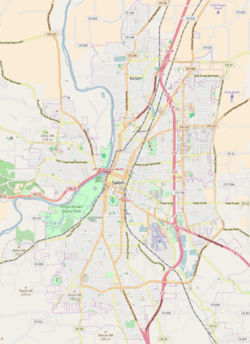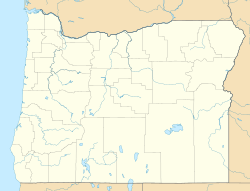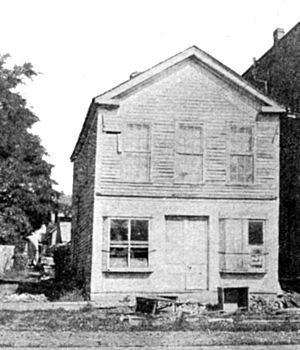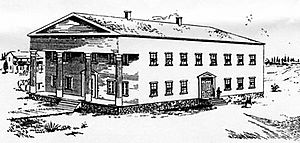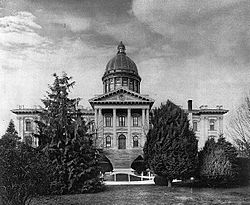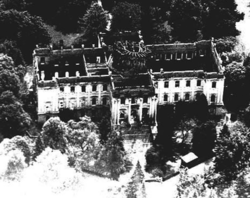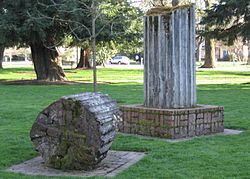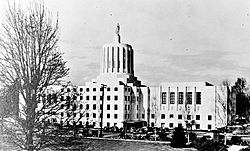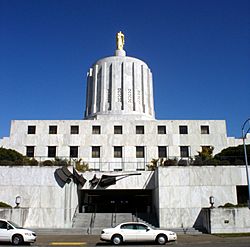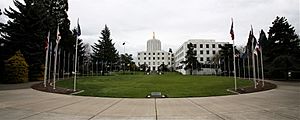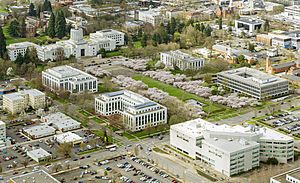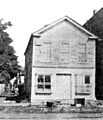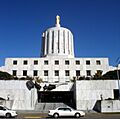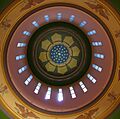Oregon State Capitol facts for kids
Quick facts for kids |
|
|
Oregon State Capitol
|
|
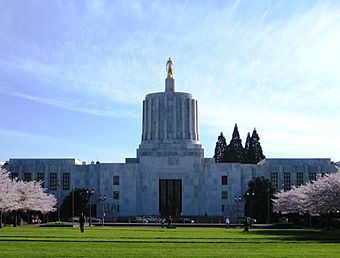
Oregon State Capitol, view from Capitol Mall
|
|
| Location | 900 Court Street NE, Salem, Oregon, U.S. |
|---|---|
| Built | October 1, 1938 |
| Architect | Trowbridge & Livingston |
| Architectural style | Art Deco, Stripped Classicism |
| NRHP reference No. | 88001055 |
| Added to NRHP | June 29, 1988 |
The Oregon State Capitol is a very important building in Oregon. It's where the state's laws are made. This building houses the state legislature, which is like Oregon's version of Congress. It also has offices for the governor, the secretary of state, and the treasurer.
The Capitol is located in Salem, which is the capital city of Oregon. The building you see today is the third one built in Salem. The first two capitols were sadly destroyed by fire. One burned in 1855 and the other in 1935.
The current Capitol was built between 1936 and 1938. It was designed by architects Trowbridge & Livingston from New York. They used a style called Art Deco with some Stripped Classicism. Much of the building, both inside and out, is made of marble. The Oregon State Capitol was added to the National Register of Historic Places on June 29, 1988. This means it's a special historical site.
The United States government helped pay for the building. This happened during the Great Depression, a time when many people didn't have jobs. The main part of the building cost about $2.5 million. It has a large dome that is 166 feet (51 meters) tall. Later, in 1977, new sections were added to the building. These additions doubled the space inside and cost $12.5 million. Outside the Capitol, there are cool artworks, fountains, and plants. You can see Oregon's state tree, the Douglas fir, and the state flower, the Oregon grape.
Contents
Oregon's Early Capitol Buildings
Before Oregon became a U.S. territory in 1848, its first government chose Oregon City as the capital. This happened in 1844 and 1845. One early building used as a capitol was small, only 20 by 40 feet (6 by 12 meters).
In 1850, the state government decided to move the capital to Salem. But the governor at the time, John P. Gaines, didn't want to move. He thought the decision was unfair. Eventually, in 1852, the United States Congress officially decided that Salem would be the capital.
Moving the Capital Around
On January 13, 1855, the Oregon government tried to move the capital again. This time, they wanted to go to Corvallis. Many people, including Governor George Law Curry, didn't like this idea. Public buildings were already being built in Salem. The U.S. Secretary of the Treasury said the move was not allowed without Congress's approval. So, the governor and others moved back to Salem.
On December 3, 1855, the legislature met in Corvallis. They quickly voted to move the capital back to Salem. Three days later, they met in Salem. But then, a big fire happened!
First Capitol Building and the Fire
The first permanent capitol building started being built in 1854 in Salem. It was a Greek Revival-style building. It was 50 feet (15 meters) wide and 75 feet (23 meters) long. The outside was made of stone. It had two stories and was decorated with four Ionic columns. Inside, there were rooms for the legislature, a court, and offices. The building cost $25,000 to build.
On the night of December 29, 1855, a fire destroyed this first capitol building. Many important government papers were lost. People thought someone might have started the fire on purpose, but no one was ever caught.
For many years after the fire, the capitol site was just a pile of stones. The government used a temporary building in downtown Salem from 1859 to 1876.
Second Capitol Building and Another Fire
Plans for a new capitol building began in 1872. The state set aside $100,000 for it. This second capitol was built between 1873 and 1876. It cost $325,000. The first stone was laid on October 5, 1873. Some of the construction was done by prisoners from the Oregon State Penitentiary.
This new building was made of stone and five million bricks. It was 275 feet (84 meters) long and 136 feet (41 meters) wide. It had a large dome that was 180 feet (55 meters) tall. Inside, there were chambers for the Senate and the House. The Oregon Supreme Court and the state law library were also on the top floor. The building looked like the United States Capitol in Washington, D.C. It was used from 1876 until 1935.
The 1935 Fire
On April 25, 1935, another fire broke out at the capitol. A worker called the fire department. People tried to save things from the building, but the fire spread very quickly. The flames could be seen from far away. One volunteer firefighter, Floyd McMullen, died in the fire.
The fire started in the basement and quickly went up through the building's hollow columns. The heat was so strong that it even burned the copper dome. Only the outer walls were left standing. The damage was about $1.5 million. The state didn't have insurance, so it was a huge loss. Many historical items, like portraits of past governors, were destroyed. Luckily, some valuable records were saved in fire-proof vaults. Other historical documents had been sent to the Oregon Historical Society earlier, so they were safe. After the fire, government offices moved to other buildings in Salem.
Third and Current Capitol Building
Construction of the newest capitol building began on December 4, 1936. It was finished on June 18, 1938. This makes it one of the newest capitol buildings in the U.S. The building was officially opened on October 1, 1938. Important people like President Franklin D. Roosevelt gave speeches.
The design of this new building was different from most state capitols. It has an Art Deco style. It's one of only three state capitols in the U.S. built in this style. Some people didn't like the design at first. They thought the cupola (the top part) looked like a "paint can" instead of a traditional dome. Also, the gold statue on top, called the Oregon Pioneer, took some getting used to. It was put in place on September 17, 1938.
The building cost $2.5 million. The federal government paid 45 percent of this cost. The outside of the building is made of Vermont marble. Inside, the lobby and halls are lined with polished rose travertine stone from Montana. The stairs and floor in the main rotunda use gray marble from Missouri. The walls of the legislative rooms have 158 names of famous Oregonians. Only six of these names are women.
In 1977, new wings were added to the building. This project cost $12.5 million and doubled the space. These wings added offices, meeting rooms, and underground parking. In 2002, these wings were updated for $1.3 million.
On March 25, 1993, an earthquake hit Oregon. It was called the Scotts Mills earthquake. The earthquake damaged the dome of the Capitol. The main rotunda area was closed for about two years for repairs. The repairs cost $4.3 million. Workers added more concrete and steel to make the building stronger.
In April 2002, the Oregon State Capitol became the first state capitol to use solar power. It has 60 solar panels that make 7.8 kilowatts of electricity. One-third of this power lights the Oregon Pioneer statue at night. The rest goes into the power grid.
On December 31, 2007, the Capitol hosted its first official wedding. This was for Oregon State Representative Tobias Read. In 2008, a small fire broke out in the governor's offices. It was quickly put out, but the governor had to move some of his offices temporarily.
Exterior and Interior Features
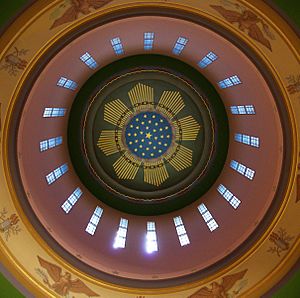
The Oregon State Capitol is where the state's House and Senate meet. It also has offices for the governor, treasurer, and secretary of state. In the middle of the building is a large, round room called the rotunda. On the floor of the rotunda, you can see the Oregon State Seal made of bronze. This seal was created by Ulric Ellerhusen. He also made the Oregon Pioneer statue on top of the dome.
The dome rises 106 feet (32 meters) above the state seal. The inside of the dome is painted with 33 stars. These stars show that Oregon was the 33rd state to join the U.S. There are also eight painted medallions near the top of the rotunda walls. They show the eight symbols from the state seal. Around the rotunda, there are four large paintings called murals. They show important moments in Oregon's history. One mural shows Captain Robert Gray exploring the Columbia River in 1792. Another shows the Lewis and Clark Expedition. The other two show covered wagons from pioneer times. These murals were painted by Frank H. Schwarz and Barry Faulkner.
The House chamber has a special carpet with Douglas fir trees on it. This represents Oregon's forestry. The furniture and walls are made of golden oak. Behind the Speaker of the House's desk is a large mural by Faulkner. It shows the 1843 Champoeg Meetings, where Oregon's first government was formed.
The Senate chamber uses black walnut wood for its walls and furniture. Its carpet has pictures of Chinook salmon and wheat. These represent Oregon's fishing and agriculture. The Senate's mural, painted by Schwarz, shows news of Oregon becoming a state reaching Salem. Both chambers have 158 names of important Oregonians carved into the walls.
On the second floor is the Governor's office. It has a ceremonial office and private offices. Like the Senate chamber, the walls are made of black walnut. The ceremonial office has a fireplace with a painting by Faulkner. In the reception area, there's a table made from 40 different types of trees. It has a picture of Oregon's second capitol building, the state flower (Oregon-grape), and the state bird (western meadowlark).
Outside the building, there are many artworks. Sculptor Leo Friedlander made large sculptures from Vermont marble near the main entrance. One shows Meriwether Lewis, William Clark, and Sacagawea. The other shows pioneers and a covered wagon. These sculptures also have maps of the Lewis and Clark Expedition and the Oregon Trail on their backs. Ulric Ellerhusen also made five marble sculptures and six bronze sculptures on the outside of the building.
The building is 693 feet (211.2 meters) long and 259.5 feet (79.1 meters) wide. The older main part is 53.5 feet (16.3 meters) tall. The newer wings added in 1977 are 68.7 feet (20.9 meters) tall. Inside, the building has about 233,750 square feet (21,716 square meters) of space.
In 1997, the Oregon State Capitol Foundation was created. This group helps preserve the Capitol's history and beauty. In 2005, they finished the Walk of the Flags project. This display in Willson Park shows the flags of all 50 U.S. states.
In 2007, the capitol wings were closed for a big renovation project. This project cost $34 million. It updated things like furniture, plumbing, and electrical systems. The renovations were finished in November 2008.
Capitol Grounds
The Capitol grounds cover three city blocks. They include Willson Park and Capitol Park. Near the west entrance, there's a smaller copy of Philadelphia's Liberty Bell. This bell is one of 53 copies given to each state by the U.S. government. Oregon got its bell on July 4, 1950.
All around the grounds, you can see native trees and shrubs. These include blue spruce, Oregon-grape (the state flower), giant sequoia, coast redwood, Japanese maple, and dogwood trees. One special Douglas fir tree was grown from a seed that went to the Moon on Apollo 14 in 1971! It was planted at the Capitol in 1976.
On the east side of the building is Capitol Park. Here you'll find a bronze statue of a person on horseback called The Circuit Rider. This statue honors early preachers. There are also statues of Jason Lee and John McLoughlin. Lee started the Methodist Mission and Willamette University. McLoughlin is known as the "Father of Oregon." In 1962, a big storm knocked over The Circuit Rider statue, but it was fixed in 1963. There's also a memorial to Oregonians who received the Medal of Honor.
To the west is Willson Park, named after Salem's founder, William H. Willson. This park has the Waite Fountain and a gazebo built in 1982. There's also a fun sculpture by Peter Helzer called A Parade of Animals (1991), which is designed for kids to play on. The Breyman Fountain is at the far west end of the park. In 2005, the Walk of Flags was added, showing the flags of all U.S. states. In 2009, the flags of Oregon's nine Native American tribes were added too.
Other cool things on the Capitol grounds include the Sprague Fountain and the Wall of Water. The Wall of Water was added in 1990. It has 22 nozzles that shoot water 12 feet (3.7 meters) into the air. The Capitol Beaver Family sculpture, added in 1985, shows Oregon's state animal, the North American beaver. You can also find a peace pole, a large boulder from the Oregon Trail, and a rose garden.
Images for kids
See also
 In Spanish: Capitolio del Estado de Oregón para niños
In Spanish: Capitolio del Estado de Oregón para niños


